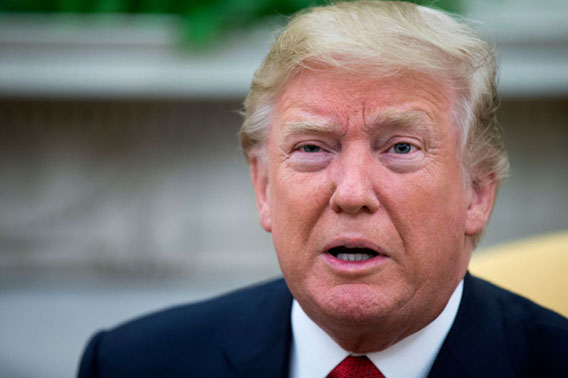 English
English

President Trump vowed to be “extremely tough” on rampant drug crime in the country, adding that he would give ‘death penalty’ to the country’s drug dealers.

Washington D.C: United States President Donald Trump on Monday reiterated that the building of US-Mexico border would help to stem the flow of illegal drugs, such as heroin and narcotics into the country.
The latest comment comes as President Trump continues to advocate the building of the border wall, which, according to him, will stop the illegal flow of immigrants from Mexico and other countries to the US.
Also Read: US President Trump to remove his national security adviser
In a speech on opioid epidemic at New Hampshire, President Trump vowed to be "extremely tough" on rampant drug crime in the country, adding that he would give 'death penalty' to the country's drug dealers.
"If we don't get tough on drug dealers, we are wasting our time, and that toughness includes the death penalty. We have got to get tough. This isn't about nice anymore," he asserted.
He spoke in front of a banner that read, "Opioids: The Crisis Next Door" and was flanked by law enforcement members.
President Trump also condoled the parents of a man in his late 20s, who died of an overdose, after he became addicted to drugs, while taking a prescription opioid, The Washington Post reported.
He vowed that his administration would be spending a lot of money on a public awareness campaign to prevent American youth from taking drugs.
Also Read: Donald Trump, Musk Twitter tiff over tariff
"That's the least expensive thing we can do, where you scare them from ending up like the people in the commercials. And we'll make them very bad commercials; we'll make them very unsavory situations," added President Trump.
The US President also called for greater access to treatment and praised American pharmaceutical companies that are making "lifesaving overdose-reversing drugs".
The Trump administration is also calling for a national prescription-drug-monitoring database, where prescriptions can be tracked across the country. Each state has its own system and some share data. The administration also wants to cut opioid prescriptions by one-third nationwide.
"The plan contains some important steps that will increase access to effective, evidence-based treatment, particularly Medication-Assisted Treatment for opioid addiction," Chuck Ingoglia, senior vice president for public policy and practice improvement at the National Council for Behavioral Health, said in a statement.
The opioid epidemic or opioid crisis is the rapid increase in the use of prescription and non-prescription opioid drugs in the United States and Canada beginning in the late 1990s and continuing throughout the first two decades of the 2000s. Opioids are a diverse class of moderately strong painkillers, including oxycodone (commonly sold under the trade names OxyContin and Percocet), hydrocodone (Vicodin), and a very strong painkiller, fentanyl, which is synthesized to resemble other opiates such as opium-derived morphine and heroin.
Also Read: Trump's Navy secretary nominee withdraws from consideration
The potency and availability of these substances, despite their high risk of addiction and overdose, have made them popular both as formal medical treatments and as recreational drugs. Due to their sedative effects on the part of the brain which regulates breathing, opioids in high doses present the potential for respiratory depression and may cause respiratory failure and death.
According to the US Drug Enforcement Administration, overdose deaths, particularly from prescription drugs and heroin, have reached epidemic levels in the country. Nearly half of all opioid overdose deaths in 2016 involved prescription opioids. From 1999 to 2008, overdose death rates, sales, and substance abuse treatment admissions related to opioid pain relievers increased substantially.
By 2015, annual overdose deaths from heroin alone surpassed deaths from both car accidents and guns, with other opioid overdose deaths also on the rise. Drug overdoses have since become the leading cause of death of Americans under 50 years, with two-thirds of those deaths from opioids. (ANI)